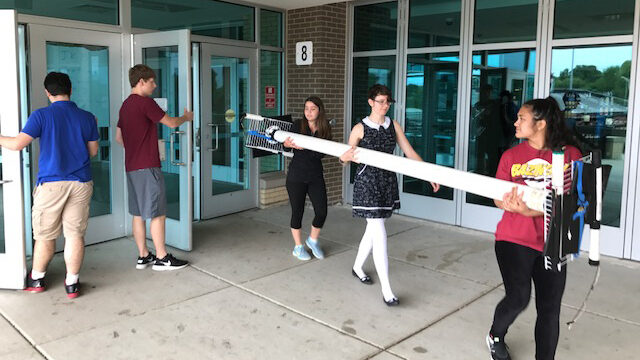While most people are marveling at Monday’s eclipse, a group of researchers will be measuring its effects on cosmic rays—particles from space that collide with the earth’s atmosphere to produce muons, heavy cousins of the electron. But these researchers aren’t the usual PhD-holding suspects: They’re still in high school.
More than 25 groups of high school students and teachers nationwide will use small-scale detectors to find out whether the number of cosmic rays raining down on Earth changes during an eclipse. Although the eclipse event will last only three hours, this student experiment has been a months-long collaboration.
The cosmic ray detectors used for this experiment were provided as kits by QuarkNet, an outreach program that gives teachers and students opportunities to try their hands at high-energy physics research. Through QuarkNet, high school classrooms can participate in a whole range of physics activities, such as analyzing real data from the CMS experiment at CERN and creating their own experiments with detectors.
“Really active QuarkNet groups run detectors all year and measure all sorts of things that would sound crazy to a physicist,” says Mark Adams, QuarkNet’s cosmic ray studies coordinator. “It doesn’t really matter what the question is as long as it allows them to do science.”
And this year’s solar eclipse will give students a rare chance to answer a cosmic question: Is the sun a major producer of the cosmic rays that bombard Earth, or do they come from somewhere else?
“We wanted to show that, if the rate of cosmic rays changes a lot during the eclipse, then the sun is a big source of cosmic rays,” Adams says. “We sort of know that the sun is not the main source, but it’s a really neat experiment. As far as we know, no one has ever done this with cosmic ray muons at the surface.”
Adams and QuarkNet teacher Nate Unterman will be leading a group of nine students and five adults to Missouri to the heart of the path of totality—where the moon will completely cover the sun—to take measurements of the event. Other QuarkNet groups will stay put, measuring what effect a partial eclipse might have on cosmic rays in their area.
Most cosmic rays are likely high-energy particles from exploding stars deep in space, which are picked up via muons in QuarkNet detectors. But the likely result of the experiment—that cosmic rays don’t change their rate when the moon moves in front of the sun—doesn’t eclipse the excitement for the students in the collaboration.
“They’ve been working for months and months to develop the design for the measurements and the detectors,” Adams says. “That’s the great part—they’re not focused on what the answer is but the best way to find it.”







